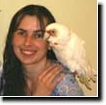Time to Separate the Sexes!
Kristen Reeves, Meadowlark Farms Avian Supply, Inc.
To gain the most productive captive finch breeding seasons, we find that separating the sexes upon completion of breeding increases our success. Before one can fully understand the importance of separating the sexes, we much first understand WHY we separate them.
In the wild, a bird's cycle is driven by light, heat & nutrition. They don’t need to be separated because the quality of the nutrition changes during each season and naturally sends them into their next cycle. Parents, chicks & juveniles move through their cycles depending on what nutrition is available at the time – the food moves them.
So why DO we separate them in captivity?
When finches are kept in mixed sexed flights, they tend to be kept in a “suspended animation” of sorts. A perpetual temptation to breed! Even if there is no nest box present, some Gouldians will attempt to breed and the hens lay anywhere, including a corner of the cage floor! In the wild they’d be lucky to raise two clutches of chicks before the weather changes and alters the availability of quality nutrition. In captivity, they should be held to no more than 3 clutches per breeding season. Any more than that is OVER BREEDING them.
Breeding, in and of itself, compromises the immune system by overloading the body with breeding hormones and stress. Over breeding depletes their calcium stores, saps their energy and opens them up to numerous opportunistic illnesses and parasites. Any time the immune system becomes compromised, the risk of illness is high. The breeding hormones lower the immune system on their own – the stress of breeding lowers it even further; Boys always competing for the girls’ attention, girls fighting off overly eager boys. The breeding hormones are rough on the system and if allowed to continue year round, can cause serious issues.
Simply put, Gouldians need a break from breeding and ample time between breeding seasons.
While keeping them separate may mean maintaining multiple cages, the advantages of the separation are great!
In most cases, if a Gouldian hen is housed with cock birds she will bond with at least one, making it almost impossible to pair her with any other cock in the same season. If we want to keep our flocks healthy, breed IN good genes and breed OUT bad ones, or even breed for a specific color combination, we need to be able to pair birds at will. When we keep the sexes separate and prevent them from seeing the opposite sex, we can almost always pair in-condition birds to the mate of our choice. We bring them into condition in their separate cages, then pair them as WE need to pair them when they are ready to breed. In most cases, an in-condition hen will accept just about any in-condition cock bird offered to her.
It’s important, however, that once birds are separated they not “see” the opposite sex. If they make visual contact, they may bond, which would defeat the main purpose of separating them!
A hen will often “bond” even through the cage bars or from across a room. Placing cock cages above or below where they cannot be observed by the hens is one way to prevent this. Placing cages side by side with solid walls or blocking the sidewalls with butcher paper is another option and what we often do here.
If we separate them, WHEN do we separate them?
In my aviary, I separate them as soon as they fully weaned and old enough to determine their sex. Because most of my juveniles begin to color up before they are weaned, I am usually able to determine almost immediately what I have in each cage. Juvenile cocks typically begin singing around the 21 day mark, and juvenile hens have a very specific warning call. Thus it is relatively easy to know which are cocks and hens at a very early age.
I then keep juveniles separate from the adults until they are fully colored. This allows them to avoid illnesses during their fragile first molt. Adults may carry bugs (strains of bacteria, for instance) that could affect the immature immune system of a juvenile. To avoid illness until juveniles complete their juvenile molt, I keep them separate.
Housing juveniles from different clutches all in the same juvenile flight does pose a risk, but it is far less than keeping juveniles in with adults who, in addition to spreading potential bugs, may also pick on the younger birds to maintain dominance and their place in the pecking order, injuring the juveniles in the process. ~k





